Teachers recognize the importance of reading aloud to their students. Reading aloud to students on a daily basis continues to have a significant impact on students’ literacy development. As members of the Children’s Literature and Reading Special Interest Group, we considered new releases that would generate appeal and interest across genres for readers.
Ages 4–8
Bee Dance. Rick Chrustowski. 2015. Henry Holt.
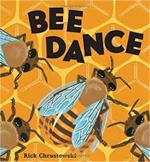 This basic informational book features a playful tone and inviting illustrations. The text has poetic appeal (Now the bees know just where to fly/Soon they see flowers reaching toward the sky), but also is heavy on content. Readers may not even realize the facts and terms (e.g., scout, forager, waggle run) they are learning about bees and their behavior. The book functions well as a picture book because of the bright collage artwork, but the text is set in a large size and printed in either black or white, so it stands out against the colorful backgrounds, making it suitable for young readers to navigate on their own. Ample back matter is provided to help readers gain a better understanding of the tidbits of information shared in the story.
This basic informational book features a playful tone and inviting illustrations. The text has poetic appeal (Now the bees know just where to fly/Soon they see flowers reaching toward the sky), but also is heavy on content. Readers may not even realize the facts and terms (e.g., scout, forager, waggle run) they are learning about bees and their behavior. The book functions well as a picture book because of the bright collage artwork, but the text is set in a large size and printed in either black or white, so it stands out against the colorful backgrounds, making it suitable for young readers to navigate on their own. Ample back matter is provided to help readers gain a better understanding of the tidbits of information shared in the story.
—LC
A Chicken Followed Me Home! Robin Page. 2015. Beach Lane/Simon & Schuster.
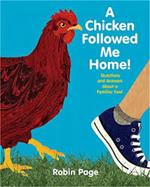 What would you do if a chicken followed you home? How would you know what kind of chicken you have? How would you feed it? These are just some of the questions posed by the unnamed narrator in this nonfiction picture book for young readers. Using a question-and-answer format, this selection offers concise facts about what chickens eat, their life cycle, and other interesting information. Each page offers visually attractive illustrations, boldfaced questions, and boldfaced key words (e.g., chick, egg). The back matter includes additional questions about chickens.
What would you do if a chicken followed you home? How would you know what kind of chicken you have? How would you feed it? These are just some of the questions posed by the unnamed narrator in this nonfiction picture book for young readers. Using a question-and-answer format, this selection offers concise facts about what chickens eat, their life cycle, and other interesting information. Each page offers visually attractive illustrations, boldfaced questions, and boldfaced key words (e.g., chick, egg). The back matter includes additional questions about chickens.
—MN
Dory and the Real True Friend. Abby Hanlon. 2015. Penguin.
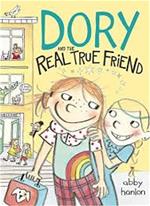 Dory from Dory Fantasmagory is back to celebrate the playful moments of childhood. In this second book, Dory is determined to make a friend. Her siblings remind her that if she wants to make new friends, she should leave her ‘imaginary’ ones at home. Dory’s free-spirited character and quest to find a like-minded friend is told with both sensitivity and gentle humor. Readers will enjoy learning more about Dory’s new REAL friend, Rosabelle, as they embark on “imaginative” outings. The return of Mrs. Gobble Gracker and Mr. Nuggey along with the amusing illustrations will leave readers giggling for more.
Dory from Dory Fantasmagory is back to celebrate the playful moments of childhood. In this second book, Dory is determined to make a friend. Her siblings remind her that if she wants to make new friends, she should leave her ‘imaginary’ ones at home. Dory’s free-spirited character and quest to find a like-minded friend is told with both sensitivity and gentle humor. Readers will enjoy learning more about Dory’s new REAL friend, Rosabelle, as they embark on “imaginative” outings. The return of Mrs. Gobble Gracker and Mr. Nuggey along with the amusing illustrations will leave readers giggling for more.
—MN
How to Read a Story. Kate Messner. Ill. Mark Siegel. 2015. Chronicle.
 Kate Messner’s latest picture book is organized into 10 easy-to-follow steps that encourage budding readers to enjoy reading. Upon opening the first double-page spread, readers meet a young boy surrounded by books of all genres and formats. As the story continues, each step serves as a “guide” to enjoy the gift of reading. Messner offers tips, such as varying inflection for different characters, pausing to think about what is happening in the story, and reading with expression. Mark Siegel’s illustrations provide visual cues to support the text. (Hint: Look closely at the book underneath the boy’s dog.) The message that reading is personal and enjoyable resounds across the pages.
Kate Messner’s latest picture book is organized into 10 easy-to-follow steps that encourage budding readers to enjoy reading. Upon opening the first double-page spread, readers meet a young boy surrounded by books of all genres and formats. As the story continues, each step serves as a “guide” to enjoy the gift of reading. Messner offers tips, such as varying inflection for different characters, pausing to think about what is happening in the story, and reading with expression. Mark Siegel’s illustrations provide visual cues to support the text. (Hint: Look closely at the book underneath the boy’s dog.) The message that reading is personal and enjoyable resounds across the pages.
—MN
Vincent Paints His House. Tedd Arnold. 2015. Holiday House.
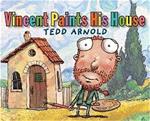 The endpapers, full of tubes of colored paint, immediately introduce the story told in this clever picture book featuring, but never naming, Vincent van Gogh. Vincent begins by painting his house white, but his companions (from the spider to the bat) all have an opinion. The repetitive pattern of Vincent choosing a color and then being interrupted will make for a dynamic read-aloud. The last page nods to van Gogh’s Starry Night painting, with a picture of the colorful house set against swirls of blue and yellow. Readers will want to see the real painting as well as images of van Gogh’s house at Arles.
The endpapers, full of tubes of colored paint, immediately introduce the story told in this clever picture book featuring, but never naming, Vincent van Gogh. Vincent begins by painting his house white, but his companions (from the spider to the bat) all have an opinion. The repetitive pattern of Vincent choosing a color and then being interrupted will make for a dynamic read-aloud. The last page nods to van Gogh’s Starry Night painting, with a picture of the colorful house set against swirls of blue and yellow. Readers will want to see the real painting as well as images of van Gogh’s house at Arles.
—LC
Ages 9–11
Circus Mirandus. Cassie Beasley. 2015. Dial Books for Young Readers.
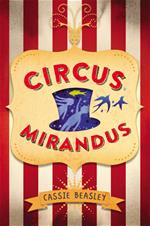 The book opens with a letter addressed to The Lightbender, reminding him that “you promised me a miracle.” The letter is from Micah Tuttle’s Grandpa Ephraim, who is dying. The two have lived together since Micah’s parents died. Now his very unsympathetic Aunt Gertrudis has moved in to help, but Micah knows the magical circus from his grandfather’s stories is the key to making thing better. When Micah and his friend Jenny meet Chintzy, the messenger (mail parrot) from Circus Mirandus, the question moves from the existence of the circus to the real power of The Lightbender. Brief chapters and intermittent illustrations make this an ideal read-aloud for a wide range of grades.
The book opens with a letter addressed to The Lightbender, reminding him that “you promised me a miracle.” The letter is from Micah Tuttle’s Grandpa Ephraim, who is dying. The two have lived together since Micah’s parents died. Now his very unsympathetic Aunt Gertrudis has moved in to help, but Micah knows the magical circus from his grandfather’s stories is the key to making thing better. When Micah and his friend Jenny meet Chintzy, the messenger (mail parrot) from Circus Mirandus, the question moves from the existence of the circus to the real power of The Lightbender. Brief chapters and intermittent illustrations make this an ideal read-aloud for a wide range of grades.
—LC
The Stars of Summer. Tara Dairman. 2015. G.P. Putnam.
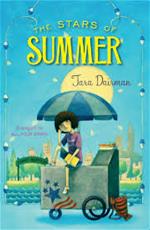 Fans of Tara Dairman All Four Stars (2014) featuring pint-size chef and (secret) restaurant reviewer, Gladys Gatsby will be delighted with her new adventures. The Stars of Summer opens with Gladys’s birthday celebration dinner with her family and friends and sprinkles just the right balance of backstory to reacquaint readers with its protagonist. Her circle of friends know about her secret and assist her in any way to help her accomplish her reviewing assignments for The Standard’s restaurant review column. But how will Gladys continue to keep this secret from her parents? How will she be able to fulfill her latest assignment of finding the best hot dog in New York City while attending summer camp? Throughout this action-packed novel, Gladys’s ingenuity, resourcefulness, love of food, wit, and determination rise to the occasion as she learns important lessons about friendship and life.
Fans of Tara Dairman All Four Stars (2014) featuring pint-size chef and (secret) restaurant reviewer, Gladys Gatsby will be delighted with her new adventures. The Stars of Summer opens with Gladys’s birthday celebration dinner with her family and friends and sprinkles just the right balance of backstory to reacquaint readers with its protagonist. Her circle of friends know about her secret and assist her in any way to help her accomplish her reviewing assignments for The Standard’s restaurant review column. But how will Gladys continue to keep this secret from her parents? How will she be able to fulfill her latest assignment of finding the best hot dog in New York City while attending summer camp? Throughout this action-packed novel, Gladys’s ingenuity, resourcefulness, love of food, wit, and determination rise to the occasion as she learns important lessons about friendship and life.
—MN
Ages 12–14
All the Answers. Kate Messner. 2015. Bloomsbury.
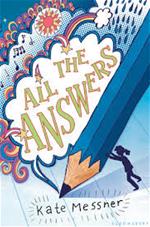 Twelve-year-old Ava Anderson, like many girls her age, worries a lot about her friends and family. While rummaging through some drawers, Ava comes across an ordinary-looking pencil—a pencil that could talk! Ava uses the magical pencil to ask questions. For example, her best friend Sophie wants to know what a popular celebrity is doing that very minute! However, after each use, the pencil has to be sharpened and becomes smaller. Soon, Ava recognizes that she needs to ask the questions more wisely to prolong its use. Throughout the novel, Ava grapples with serious concerns about those around her, including her mom’s breast cancer and the death of a loved one. This beautifully written story, with its magical realism, will certainly appeal to readers.
Twelve-year-old Ava Anderson, like many girls her age, worries a lot about her friends and family. While rummaging through some drawers, Ava comes across an ordinary-looking pencil—a pencil that could talk! Ava uses the magical pencil to ask questions. For example, her best friend Sophie wants to know what a popular celebrity is doing that very minute! However, after each use, the pencil has to be sharpened and becomes smaller. Soon, Ava recognizes that she needs to ask the questions more wisely to prolong its use. Throughout the novel, Ava grapples with serious concerns about those around her, including her mom’s breast cancer and the death of a loved one. This beautifully written story, with its magical realism, will certainly appeal to readers.
—MN
The Sign of the Cat. Lynne Jonell. 2015. Christy Ottaviano/Henry Holt.
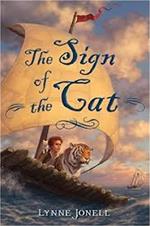 Full of mystery and adventure, this animal fantasy with a royal context will keep readers guessing and rooting for the hero. Duncan McKay can speak cat and has been told by his mother not ever to be the best or to come in first. Both of these aspects of Duncan’s life are clues to his real identity. The book is perfectly paced to scaffold readers as they put the pieces of history together. You certainly don’t have to be a cat lover to fall in love with Duncan’s cat companions, Fia and Brig. Each of the 28 chapters features a sketch with clues about the story. Teachers could use the pictures and chapter titles to invite predictions.
Full of mystery and adventure, this animal fantasy with a royal context will keep readers guessing and rooting for the hero. Duncan McKay can speak cat and has been told by his mother not ever to be the best or to come in first. Both of these aspects of Duncan’s life are clues to his real identity. The book is perfectly paced to scaffold readers as they put the pieces of history together. You certainly don’t have to be a cat lover to fall in love with Duncan’s cat companions, Fia and Brig. Each of the 28 chapters features a sketch with clues about the story. Teachers could use the pictures and chapter titles to invite predictions.
—LC
Ages 15 +
Audacity. Melanie Crowder. 2015. Philomel.
 Based on the true story of Clara Lemlich, this powerful novel in verse captures her emotions, strong will, and social activism for improved labor regulations in factories. Organized by the significant time periods of Clara’s life, author Melanie Crowder carefully weaves poignant details about Clara and her family’s immigration to the United States to Clara’s stance for equal rights. With ample use of white space, strong characterization, intense emotion, and imagery, readers glimpse into Clara’s deepest thoughts, convictions, doubts, and victories. Lemlich, determined to receive an education, attended classes after arduous work days and frequently visited the library: “I will come here after work/after my English classes/when I can/a book for dessert/after the long, hard days.” Historical notes, glossary, and an interview with Clara Lemlich’s living relatives is included. This is an outstanding selection to launch interdisciplinary subject area connections.
Based on the true story of Clara Lemlich, this powerful novel in verse captures her emotions, strong will, and social activism for improved labor regulations in factories. Organized by the significant time periods of Clara’s life, author Melanie Crowder carefully weaves poignant details about Clara and her family’s immigration to the United States to Clara’s stance for equal rights. With ample use of white space, strong characterization, intense emotion, and imagery, readers glimpse into Clara’s deepest thoughts, convictions, doubts, and victories. Lemlich, determined to receive an education, attended classes after arduous work days and frequently visited the library: “I will come here after work/after my English classes/when I can/a book for dessert/after the long, hard days.” Historical notes, glossary, and an interview with Clara Lemlich’s living relatives is included. This is an outstanding selection to launch interdisciplinary subject area connections.
—MN
Please Excuse This Poem: 100 New Poets for the Next Generation. Brett Fletcher Lauer & Lynn Melnick (Eds.). 2015. Viking.
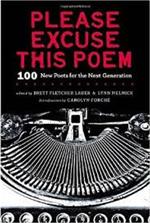 This collection of poetry is a great find for any high school teacher. Choosing poems to share daily with classes, for enjoyment or for further study, would be easy. The collection features a wide range of topics and poets from diverse backgrounds. Readers should be prepared for the treatment of challenging subjects, as exemplified by Thomas Sayers Ellis’s “Race Change Operation,” Prageeta Sharma’s “On Immigration,” and Patricia Lockwood’s “Rape Joke.” Only one poem by each writer is shared, and the collection seems meant to browse. Aspiring writers will be interested in the “about the poets” section, which contains biographical information as well as a selected set of questions and answers (e.g., first poem you loved, your idea of misery, natural talent you would most like to have).
This collection of poetry is a great find for any high school teacher. Choosing poems to share daily with classes, for enjoyment or for further study, would be easy. The collection features a wide range of topics and poets from diverse backgrounds. Readers should be prepared for the treatment of challenging subjects, as exemplified by Thomas Sayers Ellis’s “Race Change Operation,” Prageeta Sharma’s “On Immigration,” and Patricia Lockwood’s “Rape Joke.” Only one poem by each writer is shared, and the collection seems meant to browse. Aspiring writers will be interested in the “about the poets” section, which contains biographical information as well as a selected set of questions and answers (e.g., first poem you loved, your idea of misery, natural talent you would most like to have).
—LC
Additional resources about reading aloud:
Lesley Colabucci is an associate professor at Millersville University in Pennsylvania, where she teaches courses in children’s/adolescent literature. Mary Napoli is an associate professor of reading at Penn State Harrisburg, where she teaches literacy courses.
The review contributions are provided by members of the International Literacy Association’s Children’s Literature and Reading Special Interest Group.